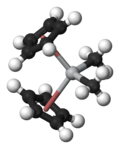- Petasis reagent
-
Petasis reagent 
 bis(η5-cyclopentadienyl)dimethyltitaniumOther namesdimethyl titanocene
bis(η5-cyclopentadienyl)dimethyltitaniumOther namesdimethyl titanoceneIdentifiers CAS number 1271-66-5 Jmol-3D images Image 1 - C[Ti](C)(C)c.c1cccc1.c2cccc2
Properties Molecular formula C12H16Ti Molar mass 208.13 g/mol Hazards Main hazards Irritant, incompatible with water and oxidizing agents  reagent (verify) (what is:
reagent (verify) (what is:  /
/ ?)
?)
Except where noted otherwise, data are given for materials in their standard state (at 25 °C, 100 kPa)Infobox references The Petasis reagent (not to be confused with the Petasis reaction) is dimethyl titanocene,[1] Cp2TiMe2, readily prepared by the reaction of methylmagnesium chloride[2] or methyllithium[3] with titanocene dichloride:
- Cp2TiCl2 + 2 "Me−" → Cp2TiMe2 + 2 Cl−
It is used for transforming carbonyl groups to terminal alkenes, much like the Tebbe reagent or Wittig reaction. Unlike the Wittig reaction, the Petasis reagent can react with a wide range of carbonyls, including aldehydes, ketones and esters.[4] The Petasis reagent is also more air stable than the Tebbe reagent, and can be isolated as a pure solid, or used directly as a solution in toluene-THF.
The active olefinating reagent, Cp2TiCH2, is prepared by heating the Petasis reagent in toluene or THF to 60 °C.
The reaction mechanism is very similar to that of the Tebbe reagent, first yielding a titanium carbene which forms a four membered oxatitanacyclobutane and than releases the terminal alkene.[5]
References
- ^ N. A. Petasis and E. I. Bzowej (1990). "Titanium-mediated carbonyl olefinations. 1. Methylenations of carbonyl compounds with dimethyltitanocene". J. Am. Chem. Soc. 112 (17): 6392–6394. doi:10.1021/ja00173a035.
- ^ Payack, J. F.; Hughes, D. L.; Cai, D.; Cottrell, I. F.; Verhoeven, T. R. (2002), "Dimethyltitanocene", Org. Synth. 79: 19, http://www.orgsyn.org/orgsyn/orgsyn/prepContent.asp?prep=v79p0019
- ^ Claus, K.; Bestian, H. (1962). "Über die Einwirkung von Wasserstoff auf einige metallorganische Verbindungen und Komplexe". Justus Liebigs Ann. Chem. 654: 8. doi:10.1002/jlac.19626540103.
- ^ Hartley, R. C.; Li, J.; Main, C. A.; McKiernan, G. J. (2007). "Titanium carbenoid reagents for converting carbonyl groups into alkenes". Tetrahedron 63: 4825–4864. doi:10.1016/j.tet.2007.03.015.
- ^ Meurer, Eduardo Cesar; Santos, Leonardo Silva; Pilli, Ronaldo Aloise; Eberlin, Marcos N. (2003). "Probing the Mechanism of the Petasis Olefination Reaction by Atmospheric Pressure Chemical Ionization Mass and Tandem Mass Spectrometry". Organic Letters 5: 1391. doi:10.1021/ol027439b.
Categories:- Organotitanium compounds
- Coordination compounds
- Reagents for organic chemistry
- Metallocenes
Wikimedia Foundation. 2010.
